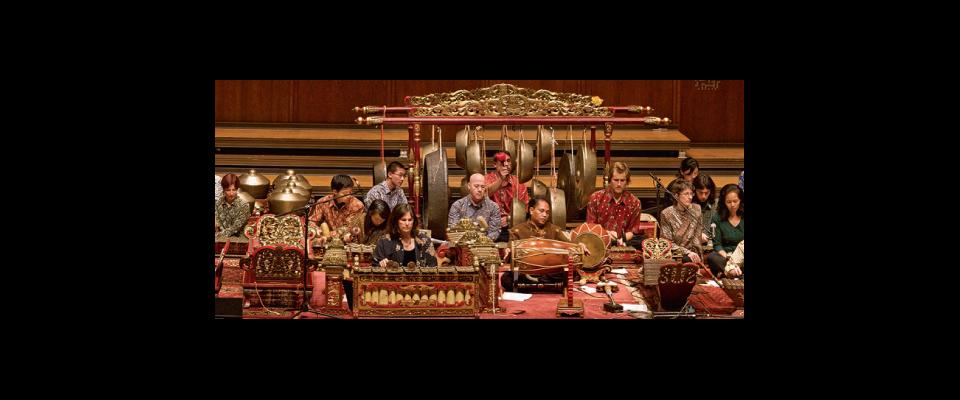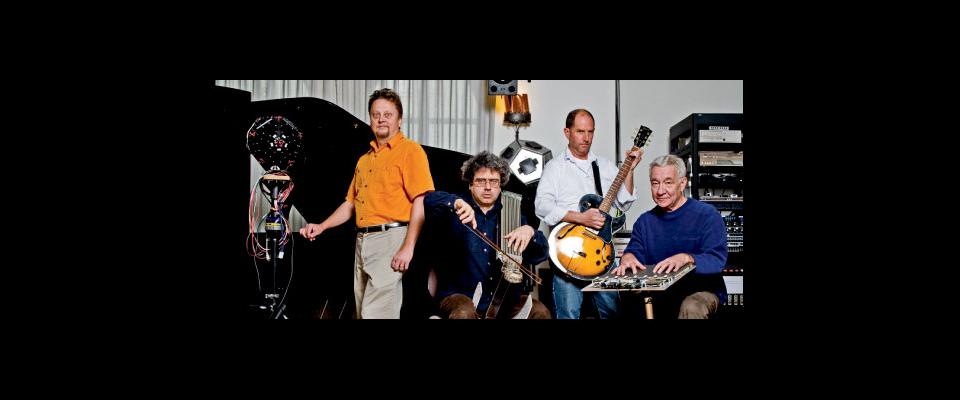The Department of Music goes beyond performance
To speak the words Berkeley and Music together is to risk a misspelling in the mind of the listener, who may hear B-e-r-k-l-e-e, as in the famous school of music in Boston. The confusion is unfortunate, since B-e-r-k-e-l-e-y‘s Department of Music is consistently ranked among the best in the country.
The comparison isn’t exactly apt either—the two programs are like different species within the genus. “Their [Berklee’s] emphasis is on performance, popular contemporary music, and producing professional musicians. We’re a music department within the University,” Ben Brinner, chair of said department, told me. “While we don’t deemphasize performance, it’s taught in tandem with theory. We treat music as an academic subject.”
Fittingly, Brinner himself is both scholar and performer—an ethnomusicologist who specializes in Middle Eastern music as well as both Balinese and Javanese gamelan, he is also codirector of Sari Raras, perhaps the best gamelan orchestra this side of the Moluccas. Much of Brinner’s research focuses on music cognition, which, he said, seeks to explain and understand “how musicians do what they do.”
Berkeley’s emphasis on music as an academic subject dates back to the department’s beginnings and the seminal influence of one of Brinner’s predecessors—Charles Seeger, father of folk legend Pete. At Berkeley, Seeger père taught the first introduction to musicology ever offered. That was in 1916, when “musicology” was still something of a neologism.
At that time and for many years afterward, the music department was a rootless orphan on campus, shunted from building to building and lacking a proper recital hall. But since 1958, home has been Morrison and Hertz Halls, a pair of Mission-style structures (pale stucco exteriors, red-tiled roofs) joined by a colonnaded passageway and perched on the south side of Faculty Glade. Architecturally, they look like something from another campus—a drop of Stanford yin in Berkeley’s yang.
No matter. Berkeley music lovers know and cherish Hertz Hall for its free concerts. Most Wednesdays and Fridays, around noon, after the Campanile and the carillon fall silent, the public is treated to performances by students, faculty, and visiting musicians in the 700-seat concert hall, considered to be one of the finest in the West for chamber music. (The carillon, incidentally, is also part of the Department of Music, and campus carillonneur Jeff Davis teaches courses in the bell-player’s art.)
Morrison Hall is given over to classrooms, practice rooms, and offices. Gamelan instruments, or more properly, “the gamelan”—an impressive assemblage of variously tuned zithers, xylophones, drums, and gongs—is housed on the second floor in what used to be the reading room of the music library. The reading (and listening) materials were moved next door after construction of the modish Jean Grey Hargrove Music Library was completed in 2003.
John Shepard is head librarian at Hargrove. Last March he led me on a tour of the holdings, which span everything from David Bowie recordings to medieval manuscripts on vellum. The latter are kept in a climate-controlled inner sanctum dubbed Case X. There, Shepard showed me a 14th-century work of uncertain authorship and written in Latin, known only as The Berkeley Theory Manuscript. Acquired at auction in 1965, the bound volume contains some of the earliest known treatises on such subjects as musical notation, tuning, and counterpoint. As he brought it down for closer inspection, Shepard said, with a measure of awe, “There have been whole books written about this book.”
Another, more contemporary work that elicits the awe of scholars is the one produced by Berkeley music professor Richard Taruskin. The six-volume Oxford History of Western Music is such an impressive feat of scholarship that a pair of graduate students in musicology—one at the University of Oregon, another at UCLA—are blogging the nearly 4,000-page work (not counting index and bibliography), which they tackle ten pages at a time. The bloggers behind “The Taruskin Challenge” compare the enterprise to scaling Mt. Everest or crossing the Amazon on foot.
There are other giants in the department too. One frequently mentioned is the musicologist-harpsichordist Davitt Moroney, who is renowned for finding lost works of the Renaissance and also for reconstructing and performing them. In February, for Cal Performances, Professor Moroney will conduct His Majestys Sagbutts and Cornetts, in a performance of one such score: Alessandro Striggio’s Missa sopra Ecco si beato giorno, thought to be Western music’s largest contrapuntal choral work.
Another star of the department is the composer/pianist Myra Melford, a wizard of improvisation who is also part of Berkeley’s Center for New Music and Audio Technologies (CNMAT), an innovative and interdisciplinary off-campus satellite devoted to exploring new sonic frontiers. Research topics at the Center include things like “Theoretical and applied spatial acoustics of loudspeaker and microphone arrays” and “eTextile and other materials for the New Lutherie.”
If all that real estate—Morrison Hall, Hertz Hall, Hargrove Library, CNMAT—sounds like a lot for one small department to lay claim to, well, it’s not as small as you might think. For many undergraduates, especially in the sciences, music is a popular double major or minor, and in any given semester, according to Brinner, more than 1,000 students will enroll in department courses. The largest of those is Music in American Culture, which boasts 400 students per semester.
Tamara Roberts, a young assistant professor in her second year at Berkeley, taught the course last semester in Hertz Hall. Flanked by speakers and wearing a small microphone from one ear, she spoke fluidly about free jazz, which followed bebop in the progression of the form. Free jazz, Roberts told the class, was “a rejection of swing” and “an expression of anti-integrationist Black politics,” a kind of “musical Blackness that wouldn’t be ignored.”
Then she played some samples: Ornette Coleman’s “Free Jazz” and Charles Mingus’s “Fables of Faubus,” Mingus’s reaction to the politics surrounding Brown v. Board of Education. Students closed their eyes or studied their feet as they listened. From the speakers came blats and bursts and squawks and squeaks as the musicians ran up and down their scales, improvising wildly yet somehow managing to walk, albeit unsteadily, that line between the cacophonous and the sublime. After a minute or two, she turned down the volume and asked, “How does that make you feel?”
A week earlier, in her rather spartan office on the second floor of Morrison, I had asked Roberts, who did her graduate work at Northwestern, how Berkeley compared to other music departments she was acquainted with. Elsewhere, she told me, the various disciplines within the departments are like different worlds. “There doesn’t tend to be much discussion across boundaries.” Composers don’t talk to musicologists, and ethnomusicology, especially, “tends to get marginalized. Here, an ethnomusicologist is the chair.”
I asked if she thinks of Berkeley as a very musical campus.
She was just beginning to reply when, as if on cue, the carillon began to play.



















